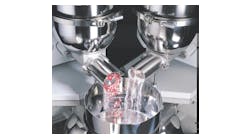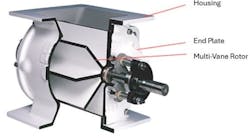When buying a new small bag or bulk bag unloading solution or replacing an existing one, here are some important things to consider.
Differences between a bag dump station and a bulk bag unloading system
Small bags are plastic or paper sacks that generally contain 50 pounds (25 kilograms) of dry material. A bag dump station, sometimes referred to as a sack tip station or manual bag dumping station, is a simple yet important piece of processing equipment that enables manufacturers to safely, efficiently and cost-effectively empty small bags of ingredients into a process.
Bulk bags are known by many names including big bags, totes, bulk sacks, and flexible intermediate bulk containers (FIBCs). Most often, bulk bags contain one ton of dry bulk material, though they may contain anywhere from a few hundred pounds to two tons, depending on the material’s bulk density. A bulk bag unloading system is suitable for when an ingredient is purchased in such large quantities to obtain price discounts or because the application uses enough of the material to make small bags inconvenient. Well-designed bulk bag unloaders offer dust-free, total emptying to allow manufacturers to quickly, safely and efficiently unload bulk material.
As with all elements of bulk material handling, challenges can arise during the bag unloading process. These challenges include dusting, poor material flow and operator safety.
Dusting. Many dry bulk materials generate dust during handling. The unloading process should be designed to minimize dust emissions during transfer from a small or bulk bag to a downstream process. It is important that processors consider dust emissions when selecting either a bag dump station or a bulk bag unloading system. Integral dust collection systems can be built into small bag dump stations and bulk bag unloaders can feature dust venting to address dusting. Bulk bag unloaders can also incorporate enclosed chambers where the bulk bag outlet is sealed to a down tube under negative pressure for a very high level of dust containment.
Poor material flow. Care must be taken to assess the material’s flowability when selecting an unloading solution. If the material will not flow from the unloader or if the flow rate does not meet production requirements, a number of features can be applied to enhance flow. Vibration is commonly used to enhance flow in both small bag dump stations and bulk bag unloaders. In some circumstances, pulsed vibration can be effective. Another solution for both types of unloaders is to use a mechanical, rotating agitator that “stirs” the product at the unloader’s outlet. This can be highly effective at ensuring material flow into the downstream process as fast as possible. Bulk bag unloaders can also feature flow-inducement mechanisms at the bulk bag, such as massage paddles operating on the bottom or sides of the bag to break up agglomerated material and promote flow.
Operator safety. Operator health and safety should be prime considerations when selecting processing equipment. It is important to ensure that the equipment will keep operators safe, healthy and working efficiently. As previously mentioned, dusting is often a focus when considering unloading equipment. Another factor is ergonomics. The operator position for both small bag dump stations and bulk bag unloaders is critical. The equipment must allow operators to easily work in a comfortable position. The lift-over height for small bag unloaders is key, but reach is also important. Operators should always interface with bulk bag dischargers at shoulder height for the purpose of untying or retying bulk bag outlet spouts. Too high or too low a reach can be a significant challenge.
Identifying the right equipment for the application
The following are three different applications requiring bag emptying solutions. In each case, the manufacturer’s unique application benefited from either a manual bag dump station, a bulk bag unloading system or both.
Leading snack food factory seeks flavor coating solution
When a global leading snack food manufacturer needed to seamlessly feed seasoning and flavors to coating machines, a few considerations were critical to find the right unloading solution.
First, the snack food company wanted to unload small bags of seasonings at a rate of 500 pounds per hour. Long batch times were acceptable for their already-established process, but they desired a cost-effective solution to fill the gaps in their unloading process. Additionally, the company needed a mobile, easy-to-clean system to enable quick cleaning between batches to prevent flavor cross-contamination. A mobile unit would be able to feed numerous machines and then be moved to a remote area for cleaning. The manufacturer also needed a low height clearance solution due to the factory layout.
Solution: Manual bag dump stations
Mobile, easy-to-clean, low-profile manual bag dump stations allowed the snack food manufacturer to meet all of its requirements. A dust hood with a transparent strip curtain and a central dust-extraction system reduced operator exposure to dust during emptying. Additionally, the units included safety interlocked access panels to allow for thorough cleaning to avoid cross-contamination of flavors between batches.
Construction industry manufacturer seeks unloading solution for cement-based products
A construction manufacturer needed a system to discharge five constituent components from 3,000-pound bulk bags into an aero mechanical conveyor for transfer into one of two mixers. In addition, batch times needed to be short due to the nature of the material. The five constituent components needed to be added to the product and continue along the process unchanged to achieve and influence certain product properties.
Solution: Loss-in-weight bulk bag unloaders
Because most of the application requirements immediately ruled out bag dump stations, the solution was to install multiple loss-in-weight bulk bag unloaders.
The application also required dust collection for operator safety as well as highly accurate weighing. The bulk bag unloaders were mounted onto load cells to accurately weigh the constituent components being discharged.
Construction manufacturer seeks increased capacity solution to meet growing demand
A manufacturer of a comprehensive range of building sealants, adhesives and fillers for a variety of markets had seen a massive increase in demand, forcing the company to rethink its existing processes. The chalk-based compounds, glass beads and titanium dioxide (Ti02) materials required handling systems that minimized both manual handling and dust emissions for operator safety.
The manufacturer needed to load bulk materials and minor additives into both existing and new mixers. The minor additives were supplied in 55-pound bags, but the bulk materials were supplied in larger bulk bags not suitable for manual unloading.
Solution: Bulk bag unloader and bag dump station
The solution included both a manual bag dump station for the minor additives and a bulk bag unloader with a load cell arrangement to accurately discharge the bulk materials.
This comprehensive solution enabled the manufacturer to handle both types of ingredients with reduced manual handling and dust emissions. The system increased capacity to meet growing demand while still protecting operators from exposure to potentially hazardous materials.
Select the right solution for optimal results
Safely and efficiently handling a variety of bulk materials through an entire manufacturing process often involves many more considerations than one may think. Whether a company is integrating a simple bag dump into a production process or installing a customized bulk bag unloading and discharging system, it is important to work with a knowledgeable and experienced equipment supplier that can offer a variety of solutions and design a process with the right features to meet the specific needs of that process.
Andy Forrester is vice president of sales for the Americas at Spiroflow Systems and a former Royal Air Force officer. He has more than 20 years of experience in senior-level roles across the powder and bulk solids, manufacturing and construction industries. He can be reached at [email protected] or at 704-246-0953.
Spiroflow Systems



